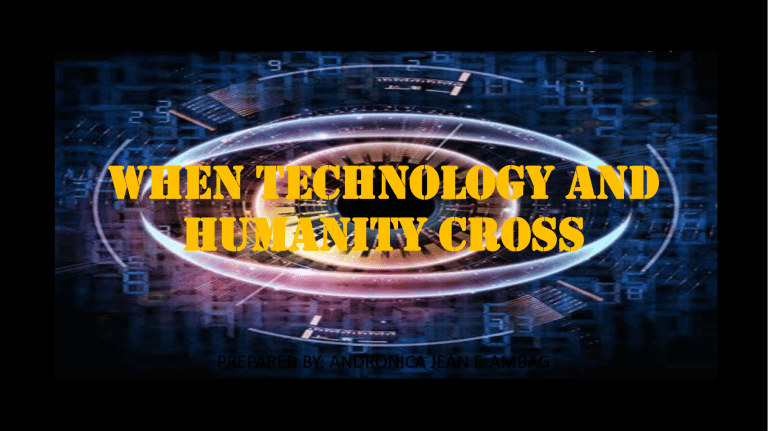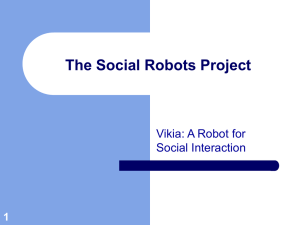
WHEN TECHNOLOGY AND HUMANITY CROSS PREPARED BY: ANDRONICA JEAN F. AMBAG •The ever- growing society has made people see technology as some sort of necessity. Tracing back its origins, the word “technology” came from the Greek words techne and logos which mean art and word respectively. TELEVISION SETS, MOBILE PHONES, COMPUTERS AND HUMANITY • According to Kantar Media, one of the most trusted television audience measurement providers, in the Philippines, 92 percent of urban homes and 70 percent of rural homes owns at least one television set. • The current count of households with television set already reached 15.135 million (Noda, 2012) • Paul Gottlieb Nipkow, a German student in the late 1800’s was successful in his attempt to send images through wires with the aid of a rotating disk. This invention was then called the “electric telescope” that has 18 lines of resolution. • After some time, in 1907, two inventors, Alan Archibald Campbell- Swinton who was an English scientist and Boris Rosing who was a Russian scientist, created a new system of television by using cathode ray tube in addition to the mechanical scanner system. • This success story gave rise to two types of television systems, the mechanical and electronic television. • Filipinos love to use their mobile phones anywhere, anytime. They use it for different purposes other than for communication. • More than half of the Filipino population own at least one (1) mobile phone regardless of type. • To prove that Filipinos really love to use their mobile phones, the Ipsos Media Atlas Philippines Nationwide Urban 2011-2012 survey results showed that one in every 3 Filipinos cannot live without a mobile phone. • In other words, 30% of the Philippines urban population nationwide said that mobile phone are necessities in life. FIRST MOBILE PHONE • Mobile phones, have a very interesting background story. On April 3, 1973, Martin Copper, a senior engineer at Motorola, made the world’s first mobile phone call. • He called their rival telecommunications company and properly informed them that he was making the call from a mobile phone. • The mobile phone used by Copper weighed 1.1 kilograms and measured 228.6 x 127 x 44.4 mm. • This kind of device was capable of a 30-minute talk time. However, it took 10 hours to charge. • In 1983, Motorola made their first commercial mobile phone available to the public. • It was known as the Motorola DynaTAC 8000X. COMPUTER • Computers and Laptops have also become part of many of the Filipino households. • There are some Filipino families who own more than one computer or laptop. • The number of computers sold per year may not be as high as the number of mobile phones and television sets. • In line with the growing number of computer sales, there has also been a growing number of internet users in the Philippines. • Charles Babbage, a 19th century English Mathematics professor, who designed the Analytical Engine which was used as the basic framework of the computers even until the present time. • In general, computers can be classified into 3 generations. Each generation of the computer was used for a certain period of time and each gave people a new and improved version of the previous one. • Laptops have been available to the public, for even a less time than personal computers. • Before, the first design of computer was so big that it could occupy whole floors of buildings. • The first TRUE portable computer was released in April 1981. it was called the Osborne 1. • A typical household owns at least four of the following devices: a mobile phone (89%), smartphone (53%), tablet (14%), desktop (39%), laptop of netbooks (37%) and a smart TV (4%) Here are some facts about Filipinos and their use of gadgets and Internet • Mobile phone subscription is at 119 million. • Filipinos spend approximately 3.2 hours on mobile phones and 5.2 hours on desktop daily. • Currently, the Philippines has one of the highest digital population in the world. • There are now 47 million active Facebook accounts in the Philippines. • The Philippines is the fastest- growing application market in Southeast Asia. Roles Played by These Technological Advancements • For instance, television is mainly used as a platform for advertisements and information dissemination. In fact, television remains to be the most used avenue by different advertising companies not only in the Philippines but all over the world. • Television also is a good platform for different propagandas and advocacies. Lastly, it can also be a good way to bond with one’s family members. • Mobile phones, on the other hand, also have their own roles in the lives of the people. They are primarily used for communication. Mobile phones offer services like texting and calling. • In the present, people use their mobile phones to surf to the internet and to take pictures more than text or to call people. • It is like an all-in-one device. • Very portable and convenient because it can fit into any space, may it be inside the pocket or bag. • Personal computers and laptops also have useful set of functions and roles. • People prefer to do their job using either a PC or laptop that a mobile phone. One reason is that laptop has a wide keyboard than using a mobile phone, especially when the mobile phone has a small screen. • Another reason is that the availability of a mouse or a touchpad made easier to maneuver than mobile phones. • Lastly, for the youth who love ton play different computer games, PC are really the better choice because it allows them to play with comfort and convenience. ETHICAL DILEMMA FACED BY THESE TECHNOLOGICAL ADVANCEMENTS • Most parents would argue that these devices make their children lazy and unhealthy. • There are some people who are more likely to experience alienation because they no longer take time to get out of their houses and mingle with other people. • Moral dilemma- people, especially children who are not capable yet of rationally deciding for themselves what is right or wrong, are freely exposed to different things in television, mobile phones, PC’s etc. HUMANS vs. ROBOTS • With the development of artificial intelligence (AI), robots may also eventually act and decide like humans. • Though the Philippines has not yet reached the point of producing robots on commercial scale for household use, it still behooves us to ponder the ramifications of replacing persons with machineries. • With the help of AI, decisions now arise from sophisticated statistical analyses made from massive data. • As of August 2017, it is estimated that a million Filipino BPO (business process outsourcing) workers may be affected and lose their jobs with the adoption of Artificial Intelligence (AI). ROBOT • A robot is an actuated mechanism programmable in tow or more axes with a degree of autonomy, moving within its environment, to perform intended tasks. Autonomy in this context means the ability to perform intended tasks based on current state and sensing without human intervention. • A service robot is a robot that performs useful tasks for humans or equipment excluding industrial automation application. NOTE: a robot may be classified according to its intended application as an industrial robot or a service robot • A personal service robot or a service robot for personal use is a service robot used for a noncommercial task, usually by laypersons. Examples are domestic servant robot, automated wheelchair, personal mobility assist robot and pet exercising robot. • A professional service robot or a service robot for personal use is a service robot used for commercial task, usually operated by a properly trained operator. Examples are cleaning robot for public places, delivery robot in offices or hospitals, fire-fighting robot, rehabilitation robot and surgery robot in hospitals. In this context, an operator is a person designated to start, monitor and stop the intended operation of a robot or a robot system. • Germany was one of the first countries to develop service robots, which was launched on October 1, 2005. • The earliest conception of robots can be traced around 300 Bc form the Egyptians. Their water clocks used human figurines to strike the hour bell. • The earliest robots as people know them were created in the early 1950s by George Devol. “Unimate” was his first invention from the words “Universal Automation”. Roles Played by Robotics • Robots play different role not only in the lives of the people but also in the society as a whole. • They are primarily used to ease the workload of mankind. They were invented to make life ore efficient and less stressful. • They perform complicated activities which human beings are incapable of doing. They perform the simplest tasks at home so that their masters can perform the complex ones without stressing themselves over the simple task. • There are robots who are made for pleasure. To be more specific, these types of robots perform activities to entertain people. LAWS FOR ROBOTS • Just like people living in a society, robots also have their own set of rules and characteristics that define what a good robots is. These laws were formulated by Isaac Asimov in the 1940s, when he was thinking of the ethical consequences of robots. • LAW ONE : a robot may not require a human being or, through inaction, allow a human being to come to harm. • LAW TW0: a robot must obey the orders given by human beings except where such orders would conflict with the first law. • LAW TRHREE: a robot must protect its own existence as long as such protection does not conflict with the first or second law. ETHICAL DILEMMAS FACED BY ROBOTICS 1. SAFETY- the safety of not only the owner of the technology but also all the people inside the house should be priority mote than anything else. 2. EMOTIONAL COMPONENT- it is just right for the robots to be given their own set of rights should they develop the ability to feel different kinds of emotion. It can be argued that the same thing happened with animals.



